
Cuts of pork, including boneless and bone-in chops, have become so lean you need to oil the pan when browning them. With marked reductions in saturated and total fat, pork chops meet U.S. Department of Agriculture standards for lean meat, on a par with skinless chicken as a low-fat protein.
Changes in Pork Fat Content
Since 1991, pork producers have worked to reduce fat content in pork by changing feeding practices and breeding. As a result, pork overall has 16 percent less fat and 27 percent less saturated fat than it did in the 1990s. In addition, changes in trimming have further reduced visible fat. Chops which displayed fat streaking or marbling and margins of fat up to 1/2 inch are now visibly free from fat in the meat and may have an edging of 1/4 inch or less of fat.
Measuring Leanness
According to the USDA, to be classified as lean, meat must have no more than 10 grams of total fat, 4.5 grams saturated fat and 95 milligrams cholesterol per cooked 3-ounce serving. Six cuts of pork meet those standards: pork tenderloin, sirloin roast, rib chops and all varieties of loin chops. This puts pork loin on a par with skinless chicken thighs, salmon and sirloin, eye round and round cuts of beef. The fat content of pork tenderloin is low enough to qualify it as an extra-lean meat, comparable to boneless, skinless chicken breast.
Oil Quantities
A tablespoon of oil, two at the most, is enough to brown four to six pork chops. Using olive, canola, safflower or other vegetable oils keeps saturated fat levels low. Searing chops at medium-high heat creates a coat of browning without letting chops soak up oil. To keep fat levels low, you may wish to remove chops from the skillet as soon as they're browned and drain them on paper towels before proceeding with your recipe.
Keeping
To help make the browning even, nick the fat around the edges, making small cuts that reach but do not penetrate the meat. This keeps the fat from shrinking around the meat, causing it to buckle in the pan. Nicking the edges lets natural shrinkage occur while letting meat sit flat against the browning surface of the pan. Once the chops are browned and the fat drained from the pan, braise or simmer the chops in a liquid to finish the cooking.
Related Articles
How to Cook a Whole 15-Pound New York ...
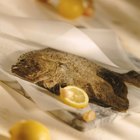
How to Roast Whole Flounder

How to Cook a Tender Top Sirloin Roast
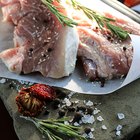
How to Cook Deer Chops in a Slow Cooker ...
How to Cook Buffalo Fillet
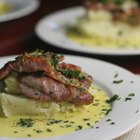
How to Cook Veal Leg Scallopini
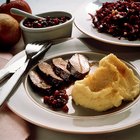
How to Make a Venison Rub

How to Cook Boneless Lamb Fillets

How to Grill a Lamb Steak
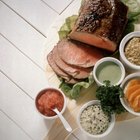
How to Cook 5 Lbs. of Beef Tenderloin
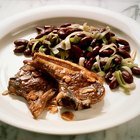
Cooking Instructions for Lamb Chops
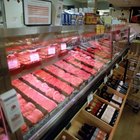
How to Cook Pork Hamonado

How to Cook Kobe Steaks

How to Use Emu Oil on Hair

Ways to Cook a Pork Loin in a Skillet

How to Cook Deer Sirloin

How to Cook 1/4-Inch Thick Pork Chops
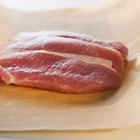
How to Cook Pork Pinwheels
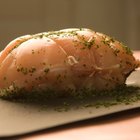
How to Braise Pork

How to Cook Bison Burger
References
Resources
Writer Bio
Janet Beal has written for various websites, covering a variety of topics, including gardening, home, child development and cultural issues. Her work has appeared on early childhood education and consumer education websites. She has a Bachelor of Arts in English from Harvard University and a Master of Science in early childhood education from the College of New Rochelle.
Photo Credits
Jupiterimages/liquidlibrary/Getty Images